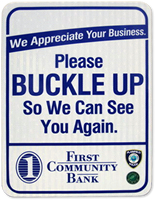The history of seat belt usage
For many Americans, safety measures like buckling into a car are almost second nature. Not surprisingly, in 2010, 85% of drivers throughout the U.S. wore seat belts. Seat belt usage hasn’t always been so widespread, though. Even as few as 30 years ago, in 1982, only 11% of drivers used seat belts. Ever since the 1960s, the number of people using seat belts has risen steadily due to new legislation and innovative legal initiatives.
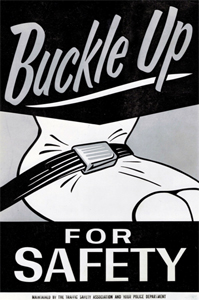
Since the early 1960s, posters like this one, from Detroit in 1962, have been used to encourage drivers to stay safe on the road.
Public concern about seat belts and road safety dates back to the 1960s, when the government began to study the effects of seat belts. It wasn’t until 1965 that every state had a law that required seat belts in the front seats of automobiles. Even then, there were no legal consequences for failing to use seat belts or helmets when riding motorcycles or motorized scooters. This increased interest in roadway safety led to a number of studies and campaigns to increase public awareness about road safety issues. Many of these campaigns involved public service announcements in the form of posters or signs, which did everything from encouraging seat belt usage and discouraging distractions to promoting the wearing of helmets. These types of initiatives continued throughout the ‘70s, but seat belt usage rates, in spite of the obvious safety benefits, still remained quite low.
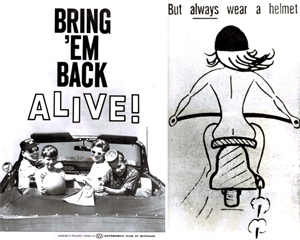
Safety campaigns in the ‘60s weren’t limited to seat belt use. The poster on the left is an American attempt to generally encourage safe driving, whereas the poster on the right is a humorous (and controversial) British attempt to increase helmet use.
In the ‘80s, seat belt usage rates dramatically increased. In terms of sheer numbers, the institution of mandatory seat belt laws had an immense impact on usage rates. In 1984, New York became the first state to mandate seat belt usage. By the end of 1995, every state but New Hampshire had passed some sort of law requiring drivers to wear seat belts. At present, state seat belt laws generally fit into one of two categories: primary-offense states and secondary-offense states. In 32 states, not wearing a seat belt is a primary offense, meaning that a motorist can be ticketed for failing to wear a seat belt. In 17 states, failure to wear a seat belt is a secondary offense, meaning that a driver can only be ticketed if another offense is also committed. New Hampshire is the one state that doesn’t require adults to wear seat belts, though it does require primary enforcement for children. Predictably, New Hampshire also has the lowest seatbelt usage rate of any of the 50 states at 72.2%. In most states, anyone caught driving without a seat belt can expect to pay a fine to their state government, the amount of which is determined largely by the state and whether the violation is a first offense. Some states even post signs alerting drivers of potential fines.
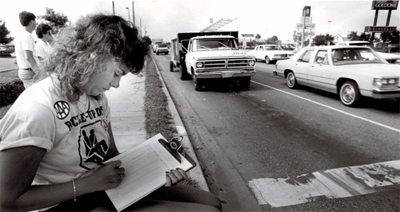
A woman working for AAA in the early 1970s in St. Petersburg, Florida, takes note of seat belt usage among drivers at an intersection.
The Click It or Ticket program has also proven to be an effective means of improving seat belt usage rates. First instituted in 1993 in North Carolina, the program aims to combine increased enforcement with increased public awareness of seat belt laws. Within six months of adoption, North Carolina saw a rise in seat belt use from 65% to over 80%. Due to the success of the North Carolina initiative, nearly every state has begun to utilize a Click It or Ticket program since 1993 – and even New Hampshire has used the campaign. Nearly every state has seen an increase in seat belt usage rates as a result of the campaign, which includes television advertisements, increased police presence on the roads, or some combination of the two.
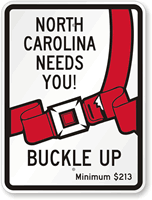
In the last 20 years, signs like this one have been posted on streets across the country as reminders to buckle up, both for safety and for legal reasons.
Though it has never been a legal requirement, seat belt signage has become fairly common throughout the country. Some signs are posted by the government as legal reminders, while posting others is merely encouraged by the local authorities. In fact, some local police departments are going further, as in Plainfield, Massachusetts, where the cops sell seat belt signs to local businesses. Signs can be an effective way to keep drivers aware of easy ways to stay safe, like buckling in.
Seat belts and other safety mechanisms have long been installed in cars, but it’s only recently that people have been consistently choosing to use them. With the assistance of government initiatives and legislation, national and state seat belt usage rates have increased dramatically since the early 1980s.
Related Posts
Category: News, Uncategorized











